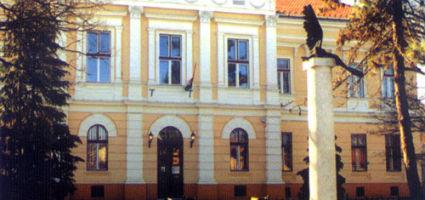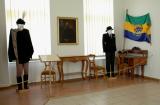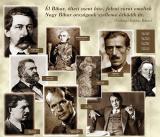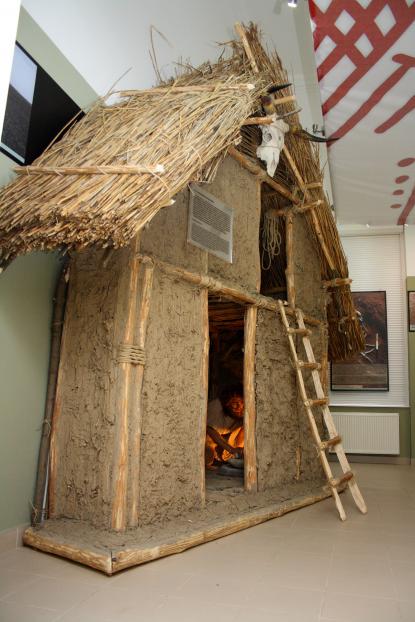2024. April 25. Thursday
Bihar Museum - Berettyóújfalu
 |
Address: 4100, Berettyóújfalu Kálvin tér 1.
Phone number: (54) 402-390, (54) 500-340
E-mail: bihari.muzeum@gmail.com
Opening hours: Mon-Fri- 10-16
|
The question of founding a museum in Berettyóújfalu surfaced first in the end of the 1950's. It was the idea of teachers and tutors. Following the work of Mrs. Sándor the museum opened on 20th August, 1960 in 7 Bihari Street. It was called the Ethnographic House. A house built around the middle of the 1700 was renovated and furnished with contemporary furniture. Unfortunately, it had to be deconstructed at the end of the sixties.
Mrs. Sándor and fellow teachers like Gábor Erdélyi did not give in, they went on collecting material. Most of the collected material was lost, but still, the Bihari Museum opened at the beginning of the seventies in 36 Kossuth Street in the old house of the Fényes family. The preparation work of Dr. Gyula Varga and collogues of the Déri Museum lasted for three months.
In 1986 the flat connected to the museum was converted into an exhibition ward and in 1989 the house in the neighborhood was bought which also enlarged the space of the display. The Tardy memorial room was organized in the building in 38 Kossuth Street.
In 1993, the Town's Hall was being renovated and preparations started to convert it to a library. It was supposed to hold an exhibition in 1996 but the works were not finished until 23 May, 2001. Then the building was ready to host the House of Public Collections, the Bihar Museum, and the István Sinka Library.
We did not hold permanent exhibitions in the past seven years but we still went on collecting material. We were donated material and bought it on the amount we won on applications. We receive more and more presents and the work of the camp of learning of our home also results numerous material. According to our diary we earned over 5000 new objects in the last ten years.
Most of oue collections grew in number. We also started a collection of natural sciences in 1998 for which a collection of minerals of eighty pieces served as a basis.
Today almost all the collection is listed in the data base of the museum.
An important event was in the life of our history when the Bihari Museum Foundation was started based on the heritage of Anna Tardy.
It is essential to mention that we first founded the Museum of Regions and Periods in Bihar. The number of the members has reached 100.
The Bihari Museum cooperates with the country houses, cultural centers, and the self-governments of the region. The villages patron the work of our camps and we help them with our researches. The help of the children created the country houses in Nagyréba and Szentpéterszeg and the forge of Hencida.
Mrs. Sándor and fellow teachers like Gábor Erdélyi did not give in, they went on collecting material. Most of the collected material was lost, but still, the Bihari Museum opened at the beginning of the seventies in 36 Kossuth Street in the old house of the Fényes family. The preparation work of Dr. Gyula Varga and collogues of the Déri Museum lasted for three months.
In 1986 the flat connected to the museum was converted into an exhibition ward and in 1989 the house in the neighborhood was bought which also enlarged the space of the display. The Tardy memorial room was organized in the building in 38 Kossuth Street.
In 1993, the Town's Hall was being renovated and preparations started to convert it to a library. It was supposed to hold an exhibition in 1996 but the works were not finished until 23 May, 2001. Then the building was ready to host the House of Public Collections, the Bihar Museum, and the István Sinka Library.
We did not hold permanent exhibitions in the past seven years but we still went on collecting material. We were donated material and bought it on the amount we won on applications. We receive more and more presents and the work of the camp of learning of our home also results numerous material. According to our diary we earned over 5000 new objects in the last ten years.
Most of oue collections grew in number. We also started a collection of natural sciences in 1998 for which a collection of minerals of eighty pieces served as a basis.
Today almost all the collection is listed in the data base of the museum.
An important event was in the life of our history when the Bihari Museum Foundation was started based on the heritage of Anna Tardy.
It is essential to mention that we first founded the Museum of Regions and Periods in Bihar. The number of the members has reached 100.
The Bihari Museum cooperates with the country houses, cultural centers, and the self-governments of the region. The villages patron the work of our camps and we help them with our researches. The help of the children created the country houses in Nagyréba and Szentpéterszeg and the forge of Hencida.



